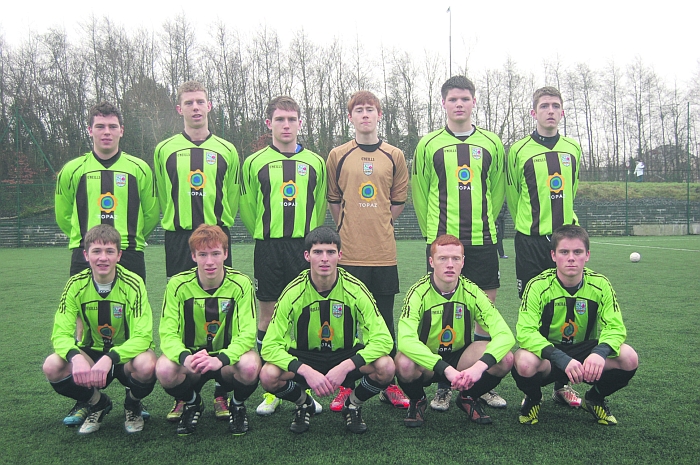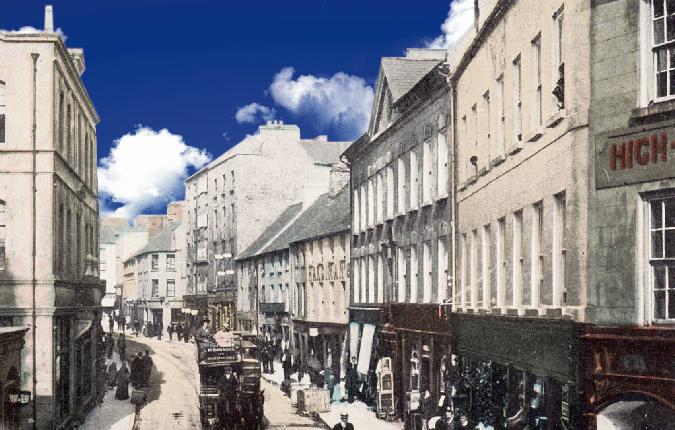Archive News
City boys struggle in schools soccer final

Date Published: 24-Jan-2013
Coláiste na Coiribe 1
Our Lady’s Belmullet 3
Keith Kelly in Castlebar
COLÁISTE Coláiste na Coiribe suffered Connacht final heartbreak for the third time in five years yesterday (Thursday) when they went down to the undisputed kingpins of Connacht B schools soccer, Our Lady’s Secondary of Belmullet, in the provincial final in Castlebar.
The game was moved from the GMIT campus in the town to the synthetic pitch of Castlebar Celtic due to a frozen pitch, and in truth the city side struggled to warm to the task against the reigning champions, who adapted far better to the artificial surface.
The Galway outfit did have the brighter start, pinning their opponents back on what was a very narrow pitch – there was just three yards between the sideline and the edge of the 18-yard box – but once Belmullet got their passing game going, they took the game by the scruff of the neck and never looked like relinquishing that grip,
They had just one goal to show at half-time for their dominance, but two goals in the space of three minutes early in the second half all but wrapped up the title, and while Coláiste na Coiribe worked hard to get back into the game – and pulled a goal back through Cathal O’Regan – they came up short against a well-drilled Mayo side.
Daithí Ó Máille caused the Belmullet defence plenty of problems down the right, and he came close to opening the scoring in the third minute when played in by Eric Ó Gionnain, but his first touch took him wide and the narrow angle proved his undoing.
Ó Gionnain then forced Belmullet ’keeper Jack Deane into a mistake when there looked to be little danger, but the ’keeper managed to scramble the ball out for a corner. Coláiste na Coiribe were unable to build on that impressive start, however, and Belmullet soon took control of what was at times an end-to-end game.
Daniel Lenihan and Caolann Malone had a busy day keeping the livewire Justin Healy under wraps, but the striker broke free in the 16th minute to test Ruairi Dempsey in the Coláiste na Coiribe goal, a test the ’keeper passed comfortably.
Dempsey then brilliantly denied the Mayo side the opener two minutes later when a corner from the left found Peter Caffrey unmarked, but his shot from six yards was brilliantly beaten away by Dempsey, and the Belmullet captain’s follow-up effort hit the post and went wide.
Kyle O’Reilly sent a shot wide from inside the box in the 24th minute, and Healy and Tommy Conroy linked up three minutes later down the right, but Conroy’s teasing ball across the face of goal eluded the inrushing attackers.
The Mayo side finally got the breakthrough on the half-hour mark when Eoin O’Donoghue got a head on Gary Boylan’s free-kick to direct the ball into the path of Conroy, and he fired home from inside the six yard box from what looked like an offside position.
It was no more than Belmullet deserved considering their dominance, and they as good as wrapped up the final early in the second half when scoring twice in three minutes. The impressive Boylan got both, the first a drive from just inside the box that gave Dempsey no chance in the 51st minute after Belmullet broke from a Coláiste na Coiribe corner; the second in the 54th minute when the midfielder pounced on a loose ball to drill home a shot from 20 yards out.
For more, read this week’s Galway City Tribune.
Galway in Days Gone By
The way we were – Protecting archives of our past

People’s living conditions less than 100 years ago were frightening. We have come a long way. We talk about water charges today, but back then the local District Councils were erecting pumps for local communities and the lovely town of Mountbellew, according to Council minutes, had open sewers,” says Galway County Council archivist Patria McWalter.
Patria believes we “need to take pride in our history, and we should take the same pride in our historical records as we do in our built heritage”. When you see the wealth of material in her care, this belief makes sense.
She is in charge of caring for the rich collection of administrative records owned by Galway County Council and says “these records are as much part of our history as the Rock of Cashel is. They document our lives and our ancestors’ lives. And nobody can plan for the future unless you learn from the past, what worked and what didn’t”.
Archivists and librarians are often unfairly regarded as being dry, academic types, but that’s certainly not true of Patria. Her enthusiasm is infectious as she turns the pages of several minute books from Galway’s Rural District Councils, all of them at least 100 years old.
Part of her role involved cataloguing all the records of the Councils – Ballinasloe, Clifden, Galway, Gort, Loughrea, Mountbellew, Portumna and Tuam. These records mostly consisted of minutes of various meetings.
When she was cataloguing them she realised their worth to local historians and researchers, so she decided to compile a guide to their content. The result is For the Record: The Archives of Galway’s Rural District Councils, which will be a valuable asset to anybody with an interest in history.
Many representatives on these Councils were local personalities and several were arrested during the political upheaval of the era, she explains.
And, ushering in a new era in history, women were allowed to sit on these Rural District Councils – at the time they were not allowed to sit on County Councils.
All of this information is included in Patria’s introductory essay to the attractively produced A4 size guide, which gives a glimpse into how these Rural Councils operated and the way political thinking changed in Ireland during a short 26-year period. In the early 1900s, these Councils supported Home Rule, but by 1920, they were calling for full independence and refusing to recognise the British administration.
“I love the tone,” says Patria of the minutes from meetings. “The language was very emotive.”
That was certainly true of the Gort Rural District Council. At a meeting in 1907, following riots in Dublin at the premiere of JM Synge’s play, The Playboy of the Western World the councillors’ response was vehement. They recorded their decision to “protest most emphatically against the libellous comedy, The Playboy of the Western World, that was belched forth during the past week in the Abbey Theatre, Dublin, under the fostering care of Lady Gregory and Mr Yeats. We congratulate the good people of Dublin in howling down the gross buffoonery and immoral suggestions that are scattered throughout this scandalous performance.
For more from the archives see this week’s Tribunes here
Archive News
Galway have lot to ponder in poor show

Date Published: 23-Jan-2013
SLIGO 0-9
GALWAY 1-4
FRANK FARRAGHER IN ENNISCRONE
GALWAY’S first serious examination of the 2013 season rather disturbingly ended with a rating well below the 40% pass mark at the idyllic, if rather Siberian, seaside setting of Enniscrone on Sunday last.
The defeat cost Galway a place in the FBD League Final against Leitrim and also put a fair dent on their confidence shield for the bigger tests that lie ahead in February.
There was no fluke element in this success by an understrength Sligo side and by the time Leitrim referee, Frank Flynn, sounded the final whistle, there wasn’t a perished soul in the crowd of about 500 who could question the justice of the outcome.
It is only pre-season and last Sunday’s blast of dry polar winds did remind everyone that this is far from summer football, but make no mistake about it, the match did lay down some very worrying markers for Galway following a couple of victories over below par third level college teams.
Galway did start the game quite positively, leading by four points at the end of a first quarter when they missed as much more, but when Sligo stepped up the tempo of the game in the 10 minutes before half-time, the maroon resistance crumbled with frightening rapidity.
Some of the statistics of the match make for grim perusal. Over the course of the hour, Galway only scored two points from play and they went through a 52 minute period of the match, without raising a white flag – admittedly a late rally did bring them close to a draw but that would have been very rough justice on Sligo.
Sligo were backable at 9/4 coming into this match, the odds being stretched with the ‘missing list’ on Kevin Walsh’s team sheet – Adrian Marren, Stephen Coen, Tony Taylor, Ross Donovan, David Kelly, David Maye, Johnny Davey and Eamon O’Hara, were all marked absent for a variety of reasons.
Walsh has his Sligo side well schooled in the high intensity, close quarters type of football, and the harder Galway tried to go through the short game channels, the more the home side bottled them up.
Galway badly needed to find some variety in their attacking strategy and maybe there is a lot to be said for the traditional Meath style of giving long, quick ball to a full forward line with a big target man on the edge of the square – given Paul Conroy’s prowess close to goal last season, maybe it is time to ‘settle’ on a few basics.
Defensively, Galway were reasonably solid with Gary Sice at centre back probably their best player – he was one of the few men in maroon to deliver decent long ball deep into the attacking zone – while Finian Hanley, Conor Costello and Gary O’Donnell also kept things tight.
For more, read this week’s Connacht Tribune.
Archive News
Real Galway flavour to intermediate club hurling battle in Birr

Date Published: 23-Jan-2013
images/files/images/x3_Courthouse.jpg










